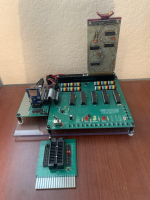Arcadetech04
Member
- Joined
- Nov 14, 2023
- Messages
- 32
Thanks for the links.
As Vince mentioned, there's an easily buildable Flip Chip tester documented here: https://github.com/G-Wiley/Flip_Chip_Test_SystemGwiley has pages about his Arduino-based version, and can probably steer you there. There's also the USB/Windows solution from M_thompson. The tester has come up in various threads here. I don't have a list to hand, so I'd suggest ufint the "Search" thingy in the corner with "flip chip tester" or the like. (I don't envy you trying to read all this on your iPhone, though.)

If you are from Gridley, then we just may know each other.As Vince mentioned, there's an easily buildable Flip Chip tester documented here: https://github.com/G-Wiley/Flip_Chip_Test_System
and a zif socket adapter here that fits into the flip chip tester: https://github.com/G-Wiley/IC_Test_Jig
I began with the work by Warren Stearns, Michael Thompson, and Vince and adapted it for the small and inexpensive ESP32. To test boards it does require a computer connected to the USB port on the ESP32 but no internet connection is required to run tests. You will need an internet connection, of course, to download the files from github and to load the Arduino software into the ESP32. Maybe take your computer to a Starbucks and load up what you need from github and the Arduino installer.
All of the test vector files are stored on a microSD card that's connected to the tester controller. You'll need a computer that runs a terminal emulator to enter test commands and observe results. Also will need a +5V power supply to power the tester and board under test.
There's an extensive library of Flip Chip board test vector files on Vince's website which is linked from my github,
and some additional Flip Chip test vector files are here: https://github.com/G-Wiley/Flip_Chip_test_procedures_and_vectors.
I may also be from a similar decade and grew up in Gridley, so a well-seasoned north-valley person can do this
I might even have an extra tester pcb and tester controller pcb in boxes under my desk, need to check.
Tester board with test controller to the left mounted on an acrylic square. M160 Flip Chip is plugged into the tester. IC Test Jig is in the foreground.
(tap the image to enlarge it)
View attachment 1269350
I think I did, but I’ll check again.Did you look at my repair thread when I fixed both my pdp8/L's? I ordered one of those 74xxx chip testers with a clip on cable and used that to fix the major registers, M113's, the 4,6,and 8 input NAND gate boards and the flip flop boards by testing the chips in circuit. Makes a MASSIVE difference in the resulting system, then you can start testing knowing that something is good.....
C
Have to remember that this machine was introduced in 1968, and things were quite primitive back then, compared to how things were done a decade or two or three later.Thanks for the information.
I must be spoiled, because I am an Arcade tech, our manuals have a Diagnostic menu. It would that the 8/L does not. Bummer Dude.
As part of my SIMH testing, I've looked into rounding up the acceptance tests for various models. I show the 8/L acceptance test as being:Vince has a good collection of the maindecs on his site. Here is a link to that section. https://so-much-stuff.com/pdp8/software/dec.php#maindec
